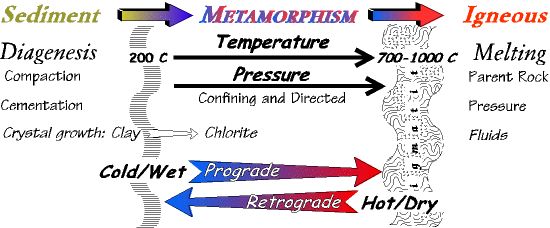The Mechanisms of Metamorphism

METAMORPHISM: The mineralogical and textural changes that occur in a rock in response to changes in temperature and pressure, short of melting
.
The changes in a rock that include metamorphism begin with digenesis (conversion of a loose sediment into a rock), pass through the mineral and textural changes of metamorphism, and end with the melting of the rock.
Metamorphism is a two way street, however. Prograde metamorphism begins with cold, fluid (water) rich rocks and proceeds to hot and dry rocks. But, if the temperature and pressure decline then the rock undergoes retrograde metamorphism as the rocks and minerals adjust to the reduced temperature and pressure.
Prograde and retrograde metamorphism are not balanced processes. Prograde metamorphism takes place faster, and produces more dramatic change because of the presence of water in the rocks (see explanation of the difference water makes). Retrograde metamorphism, beginning with a dry rock, is slower, and does not produce as dramatic a change.
And, of course, retrograde metamorphism can never take you back to the parent rock. Igneous and sedimentary rocks can only be produced by igneous and sedimentary processes.
There are two main mechanisms of metamorphism,
heat and pressure.
heat and pressure.
HEAT:
There are two sources of heat, one comes from the geothermal gradient - the increase in temperature that occurs with increase in depth in the earth. The average geothermal gradient is approximately 1 degree C for every 30 meters (~100 feet) of depth, although under local conditions it may vary from this ideal.
The second source of heat is from intrusive bodies of magma, such as batholiths. As these bodies cool they release heat to the surrounding country rock, leading to metamorphism.
At the extreme end of metamorphism melting takes place. The melting temperature for a rock ranges from a low of 700-800 degrees C to as high at 1000 degrees C. The melting temperature is controlled by a number of things. For example, the composition of the parent rock. Take a granite vs a basalt parent rock, both being metamorphosed. Because a basalt crystallizes at a higher temperature than a granite (i.e. is higher in Bowen"s reactions series), it takes more temperature to melt a basalt.
But other factors are equally important in determining melting temperature. Pressure: the higher the pressure, i.e. the deeper the rock is, the more temperature it takes to melt it. Conversely, a very deep, hot rock brought to the surface quickly will melt very quickly because of the decrease in pressure. It is akin to what happens in a pressure cooker. The increasing pressure in the cooker causes the water to boil at a higher temperature, thus the food cooks more quickly, but if the pressure is suddenly released the water flashes to steam.
Fluids are also important in melting. The more fluids there are, typically water, but others as well, the easier it is for the rock to melt. Fluids allow the chemicals to move more quickly and easily, and the increased mobility makes for easier melting. Conversely, a dry rock is very hard to get to change. Without the fluids chemical changes are just harder to take place.
PRESSURE:
There are two types of pressure involved in metamorphism: confining pressure and directed pressure.
Confining pressure (also hydrostatic) is equal in all directions and comes from the weight of the overlying rock - buial. It is analagous to the pressure you feel when diving deep in a swimming pool - it presses in on you equally on all surfaces.
 Directed pressure (stress) is not equal in all directions and is associated with mountain building processes when rock is squeezed, crumpled, and stretched as one continent slides over the edge of another.
Directed pressure (stress) is not equal in all directions and is associated with mountain building processes when rock is squeezed, crumpled, and stretched as one continent slides over the edge of another. Pressure not only influences the rate and degree of metamorphism, with deeply buried rocks requiring more time and heat to undergo a particular metamorphic processs, pressure also causes textural changes in the rock (more later) - how large the crystals are and their orientations - that are so distinctive of metamorphic rocks.
The sum total of metamorphic processes, then, are:
1. New mineral compositions, some typical of igneous rocks and some unique to metamorphic rocks.
2. New textures unique to metamorphic rocks.
Back To:
On To: